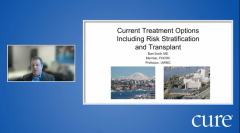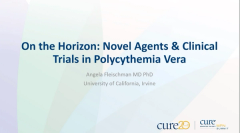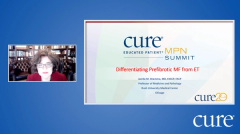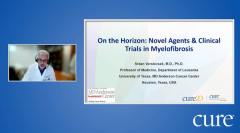
Educated Patient® MPN Summit Novel Agents and Clinical Trials in Polycythemia Vera Presentation: May 7, 2022
Watch Dr. Angela Fleishman, from the University of California Irvine, discuss novel agents and clinical trials in polycythemia vera, during the CURE Educated Patient MPN Summit.
Episodes in this series

Treatment is continuing to advance for patients with polycythemia vera (PV), with a new focus in reducing symptom burden, according to an expert.
Dr. Angela Fleischman, associate professor in the Division of Hematology/Oncology at the University of California Irvine, presented further on this topic at CURE®’s Educated Patient® MPN Summit.
A current area of interest in PV, she explained, is reducing the hematocrit (red blood cells) without increasing the risk of thrombosis or making patients iron deficient. “This is clearly an area of need for (PV),” she said during the presentation. Keeping the hematocrit levels below 45 will reduce risk of death from cardiovascular causes or major thrombotic events in patients with PV, she explained.
She further explained about a protein called hepcidin, which is important for the body to utilize the iron that it has. In PV, when people have too much blood, hepcidin could increase and be made so that even though the body has iron, it cannot make red blood cells.
Therefore, this is now the focus for new, novel agents in the PV space.
“The rationale for utilizing these agents that either mimic hepcidin or up regulate hepcidin are based on the idea that even though somebody is getting a phlebotomy, the hematocrit is only checked once in and while. And so even though (patients) are phlebotomizing for their hematocrit, when it is seen below 45, (the patient) is probably spending a significant amount of time that isn’t adequate or above 45 because it hasn’t been checked and iron deficiency is a real issue in (PV),” she explained.
Fleischman highlighted two novel agents that are currently under investigation for the treatment of PV: Rusfertide (PTG-300) and a compound called ISIS 702843.
“The central goal (of both) is to increase hepcidin so that a PV patient’s body cannot use the iron to make red blood cells and they do it in two different ways,” she added.
Rusfertide is a drug made to look like hepcidin to the body, she explained, and is currently far along in clinical trials. At the 2021 American Society of Hematology Annual Meeting and Exposition it was presented that Rusfertide controlled hematocrit and eliminated the requirements for phlebotomy in patients with PV.
The ISIS compound increased hepcidin in a different mechanism, Fleischman explained. This agent utilizes the liver to help increase the production of hepcidin.
“That’s sort of complicated but to make it less complicated, basically it gets rid of an inhibitor of hepcidin, so that it will increase the body’s natural production of hepcidin,” she explained.
Earlier Development
Fleischman also discussed two other treatment approaches that are currently under early development in her personal lab. One of them being a healthy diet approach to reduce inflammation in patients with myeloproliferative neoplasms (MPNs), including PV.
“The reasoning is that MPN patents, including PV patients, can have increased inflammation and that can contribute to many of their symptoms,” she said, adding that this would be a low-cost treatment option for patients.
There have been two pilot studies that demonstrated utilizing a Mediterranean diet — which is rich in anti-inflammatory compounds — in patients with MPNs can be beneficial. Next steps will include a larger study that will evaluate the symptom burden reduction in association with diet.
She also mentioned the antioxidant N-Acetylcysteine, which has already been used for many years as an antidote for Tylenol overdose and has been made available for over-the-counter use.
“Our first step with this agent is to identify the appropriate dose of N-Acetylcysteine for patients with MPNs. So, we currently have open and optimal dose finding study N-Acetylcysteine in patients with MPNs,” Fleischman concluded.
For more news on cancer updates, research and education, don’t forget to














